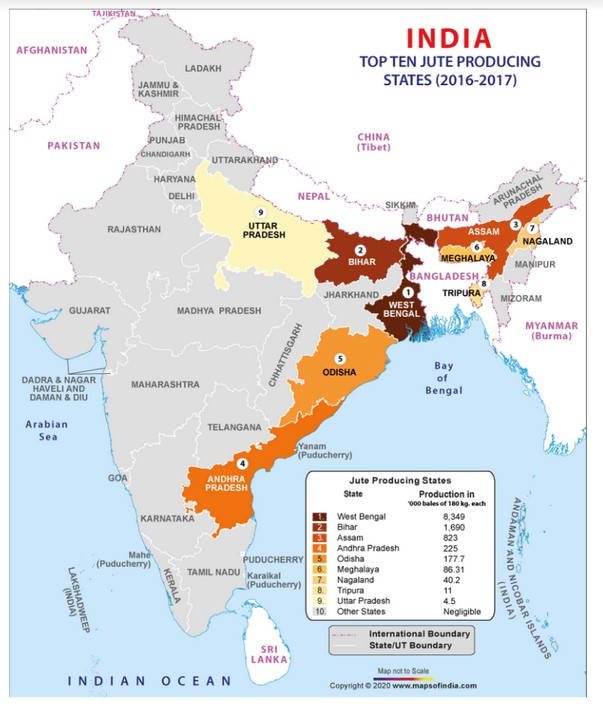Member of Parliament (MP) from Barrackpore constituency in West Bengal met Textile Minister to apprise him about issues concerning jute farmers, workers and the overall jute industry.

About jute:
- The jute plant needs a plain alluvial soil and standing water. Soft water is necessary for jute production.
- The suitable climate for growing jute (warm and wet) is offered by the monsoon climate, during the monsoon season.
- Temperatures from 20 to 40 °C (68–104 °F) and relative humidity of 70%–80% are favorable for successful cultivation. Jute requires 5–8 cm (2–3 in) of rainfall weekly, and more during the sowing time.
Significance of jute:
- Compared to rice, jute requires very little water and fertiliser and is largely pest-resistant
- Jute is the second most abundant natural fibre in the world.
- It has high tensile strength, acoustic and thermal insulation, breathability, low extensibility, ease of blending with both synthetic and natural fibres, and antistatic properties.
- Jute can be used: for insulation (replacing glass wool), geotextiles, activated carbon powder, wall coverings, flooring, garments, rugs, ropes, gunny bags, handicrafts, curtains, carpet backings, paper, sandals, carry bags, and furniture.
Issue now:
- Mills are now procuring raw jute at prices higher than what they are selling them at after processing.
- Mills do not acquire their raw material directly from the farmers as the farmers are far-off from the mills locations and the procurement process is cumbersome.
- Mills would have to go to multiple farmers to acquire the requisite quantity as no single farmer produces enough to fulfil the requirements of the entire mill.
- The procurement now flows through middlemen or traders. As a standard practice, the middlemen charge mills for their services which has led to the situation.
- The occurrence of Cyclone Amphan in May 2020 and the subsequent rains in major jute producing States led to lower acreage, which in turn led to lower production and yield compared to previous years.
- This led to production of a lower quality of jute fiber in 2020-21 as water-logging in large fields resulted in farmers harvesting the crop prematurely.
- Acreage issues were accompanied by hoarding at all levels – right from the farmers to the traders.
Comparison with Bangladesh:
- India is the largest producer of jute followed by Bangladesh and China.
- However, in terms of acreage and trade, Bangladesh takes the lead accounting for three-fourth of the global jute exports in comparison to India’s 7%.
- Bangladesh is better in producing superior quality jute fibre due to less infrastructural constraints and varieties suitable for the country’s agro-climate.
- Bangladesh provides cash subsidies for varied semi-finished and finished jute products.
- Hence, the competitiveness emerges as a challenge for India to explore export options in order to compensate for the domestic scenario.
READ MORE: Daily Prelims Booster
READ MORE: Daily News Analysis

Leave a Comment